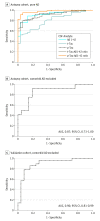A 2-Step Cerebrospinal Algorithm for the Selection of Frontotemporal Lobar Degeneration Subtypes
- PMID: 29554190
- PMCID: PMC5885205
- DOI: 10.1001/jamaneurol.2018.0118
A 2-Step Cerebrospinal Algorithm for the Selection of Frontotemporal Lobar Degeneration Subtypes
Abstract
Importance: Cerebrospinal fluid (CSF) core Alzheimer disease (AD) biomarkers have shown an excellent capacity for the in vivo detection of AD. Previous studies have shown that CSF levels of phosphorylated tau (p-tau) also correlate with tau pathology in frontotemporal lobar degeneration (FTLD) after accounting for AD copathology.
Objective: To develop an algorithm based on core AD CSF measures to exclude cases with AD pathology and then differentiate between FTLD-tau and FTLD transactive response DNA-binding protein of approximately 43kDa (FTLD-TDP).
Design, setting, and participants: A case-control study at the University of Pennsylvania. Participants were selected from a database of 1796 patients included between 1992 and 2016 with different neurodegenerative diseases with available CSF. Three patient cohorts were included: a cohort of patients with sporadic, autopsy-confirmed FTLD and AD (n = 143); a cohort of patients with frontotemporal degeneration (FTD) with TDP-associated or tau-associated mutations (n = 60); and a living cohort of patients with syndromes highly predictive of FTLD (progressive supranuclear palsy and FTD-amyotrophic lateral sclerosis; n = 62).
Main outcomes and measures: Cerebrospinal fluid values of amyloid β1-42 (Aβ1-42), total tau (t-tau), and p-tau obtained using the INNO-BIA AlzBio3 (xMAP; Luminex) assay or INNOTEST enzyme-linked immunosorbent assay transformed using a previously validated algorithm. Sensitivities and specificities for differentiating AD from FTLD groups were calculated.
Results: This autopsy cohort included FTLD-tau (n = 27; mean [SD] age at onset, 60.8 [9.7] years), FTLD-TDP (n = 13; mean [SD] age at onset, 62.4 [8.5] years), AD (n = 89, mean [SD] age at onset, 66.5 [9.7] years); and mixed FTLD-AD (n = 14, mean [SD] age at onset, 70.6 [8.5] years).The p-tau/Aβ1-42 ratio showed an excellent diagnostic accuracy to exclude AD cases in the autopsy cohort with single neurodegenerative pathologies (area under the curve [AUC], 0.98; 95% CI, 0.96-1.00). Cerebrospinal fluid p-tau levels showed a good AUC (0.87; 95% CI, 0.73-1.00) for discriminating pure FTLD-TDP from pure FTLD-tau. The application of an algorithm using cutpoints of CSF p-tau to Aβ1-42 ratio and p-tau allowed a good discrimination of pure FTLD-TDP cases from the remaining FTLD-tau and mixed FTLD cases. The diagnostic value of this algorithm was confirmed in an independent cohort of living patients with progressive supranuclear palsy and FTD-amyotrophic lateral sclerosis (AUC, 0.9; 95% CI, 0.81-0.99). However, the algorithm was less useful in FTD cases carrying a pathogenic mutation (AUC, 0.58; 95% CI, 0.38-0.77) owing to elevated p-tau levels in TDP-associated mutation carriers.
Conclusions and relevance: Alzheimer disease CSF core biomarkers can be used with high specificity for the in vivo identification of patients with pure FTLD-TDP and FTLD-tau when accounting for comorbid AD and genetic status.
Conflict of interest statement
Figures


References
-
- Lleó A, Cavedo E, Parnetti L, et al. . Cerebrospinal fluid biomarkers in trials for Alzheimer and Parkinson diseases. Nat Rev Neurol. 2015;11(1):41-55. - PubMed
Publication types
MeSH terms
Substances
Grants and funding
LinkOut - more resources
Full Text Sources
Other Literature Sources

